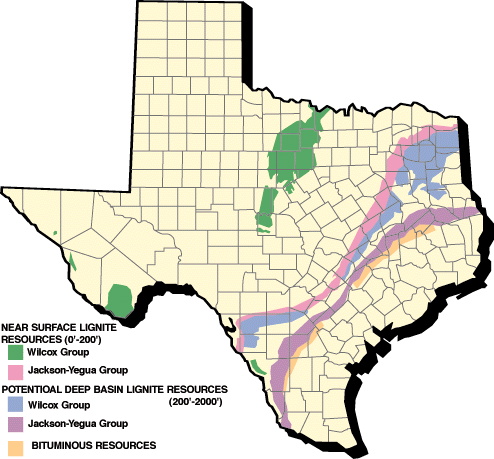Coal Seams - northeast Texas
Coal is mined throughout northeast Texas.
At the location of this earthcache, several coal seams crop out at the surface along Highway 259. You can do this earthcache as a “road side” cache. Part of the cache is visible on private property, but there is no need to go there to answer the questions needed in order to log this cache as a find.
Coal deposits in northeast Texas typically occur in the Wilcox Group. These stratigraphic coal seams occur throughout parts of Bowie. Camp, Cass, Franklin, Henderson, Hopkins, Morris, Navarro, Rains, Titus, Van Zandt and Rains counties. Depth of the coal seams range from surface outcrops to 2,00 feet and range from a foot to 17 feet in thickness (average width is 4 feet).
Coal Classification
There are four basic kinds of coal, in increasing order of alteration, are:
1. lignite (brown coal--immature),
2. sub-bituminous,
3. bituminous, and
4. anthracite (mature).

Coal starts off as peat. After a considerable amount of time, heat, and burial pressure, it is metamorphosed from peat to lignite. Lignite is considered to be "immature" coal at this stage of development because it is still somewhat light in color and it remains soft. As time passes, lignite increases in maturity by becoming darker and harder and is then classified as sub-bituminous coal. As this process of burial and alteration continues, more chemical and physical changes occur and a the coal is classified as bituminous. At this point the coal is dark and hard. Anthracite is the last of the classifications, and this terminology is used when the coal has reached ultimate maturation. Anthracite coal is very hard and shiny.
The degree of alteration (or metamorphism) that occurs as a coal matures from peat to anthracite is referred to as the "rank" of the coal. Low-rank coals include lignite and sub-bituminous coals. These coals have a lower energy content because they have a low carbon content. They are lighter (earthier) and have higher moisture levels. As time, heat, and burial pressure all increase, the rank does as well. High-rank coals, including bituminous and anthracite coals, contain more carbon than lower-rank coals which results in a much higher energy content. They have a more vitreous (shiny) appearance and lower moisture content then lower-rank coals.

Northeast Texas Coal Geology
Coal deposits in northeast Texas are often referred to Lignite, which is a soft brown combustible sedimentary rock that is formed from naturally compressed peat. It is considered the lowest rank of coal due to its relatively low heat content. Its color ranges from almost yellow to brown to balck and has a carbon content of around 25-35%, a high inherent moisture content sometimes as high as 66%, and an ash content ranging from 6% to 19% As such, it is used almost extensively for power generation.
Lignite begins as an accumulation of partially decayed plant material, or peat. Burial by other sediments results in increasing temperature, depending on the local geothermal gradient and tectonic setting, and increasing pressure. This causes compaction of the material and loss of some of the water and volatile matter (primarily methane and carbon dioxide). This process, called coalification, concentrates the carbon content, and thus the heat content, of the material. Deeper burial and the passage of time result in further expulsion of moisture and volatile matter, eventually transforming the material into higher rank coals such as bituminous and anthracite coal. Lignite deposits are typically younger than higher rank coals, with the majority of them having formed during the Tertiary period.
Logging Requirements:
You are encouraged, but not required, to take a picture with you and one or more of the coal seams in the background. However, to log this cache as a find, you must email the cache owner the answers to the following questions:
1. What is the color of the coal seam? Can you ascertain its classification due to its color?
2. How many coal seams are there on the hillside?
3. From the listed coordinates take a close look at the second seam from the highway and describe its color and texture (sandy, hard, sharp-edged rock, brittle etc.) Then, go 300 feet north along the highway and look at the second seam from the highway again. Did the color and/or texture change?
To learn more about Earthcaches, including how to develop one of your own click here Earthcache.org. You can also obtain one or more of the following levels of the Earthcache Masters Program:
BRONZE (log three or more earthcaches in at least two or more states/countries),
SILVER (log six or more Earthcaches in at least three or more states/countries and develop one Earthcache),
GOLD (log twelve or more Earthcaches in at least four or more states/countries and develop two Earthcaches), or
PLATINUM (log twenty or more Earthcaches in at least five or more states/countries and develop three Earthcaches.
Sources: AAPG (American Association of Petroleum Geologists), RRC (Rail Road Commission of Texas), differencebetween.net, britannica.com and wilkipedia.com.
 To learn more about earthcaches, including how to develop one of your own click here Earthcache.org. You can also obtain one or more of the following levels of the Earthcache MastersProgram:
To learn more about earthcaches, including how to develop one of your own click here Earthcache.org. You can also obtain one or more of the following levels of the Earthcache MastersProgram:
BRONZE (log three or more earthcaches in at least two or more states/countries
SILVER (log six or more earthcaches in at least three or more states/countries and develop one earthcache),
GOLD (log twelve or more earthcaches in at least four or more states/countries and develop two earthcaches), or
PLATINUM (log twenty or more earthcaches in at least five or more states/countries and develop three earthcaches).